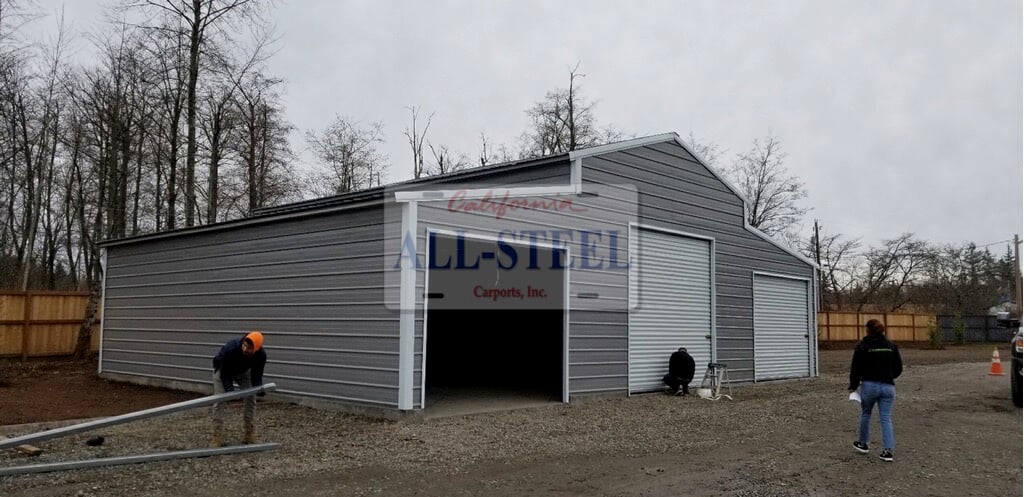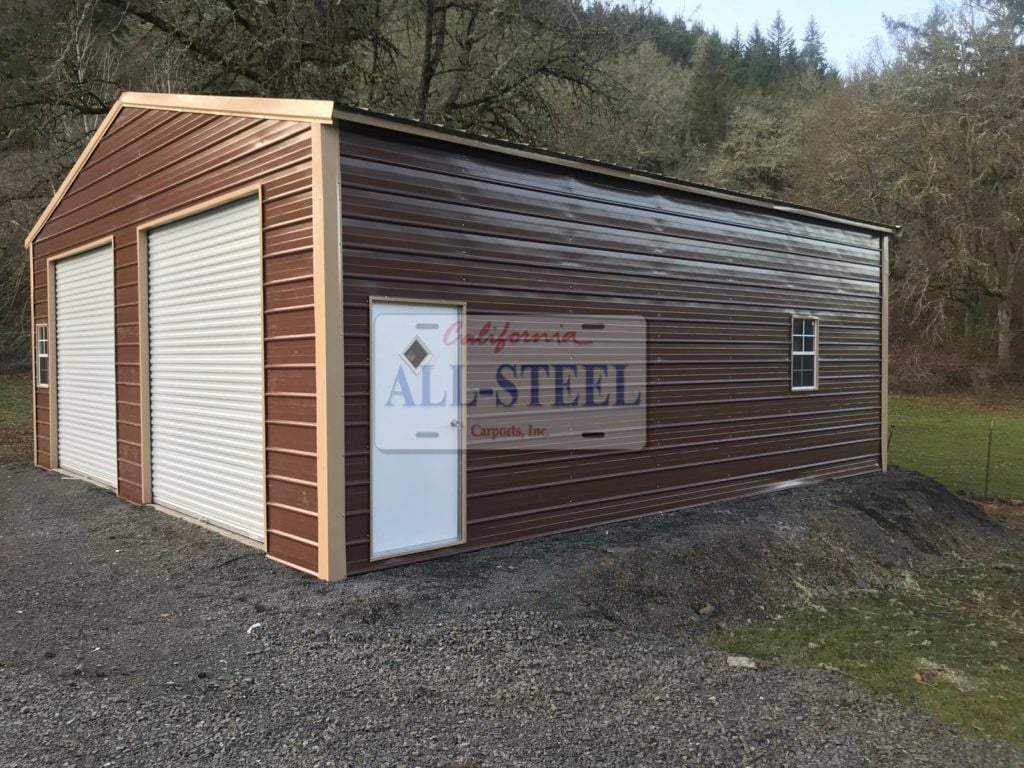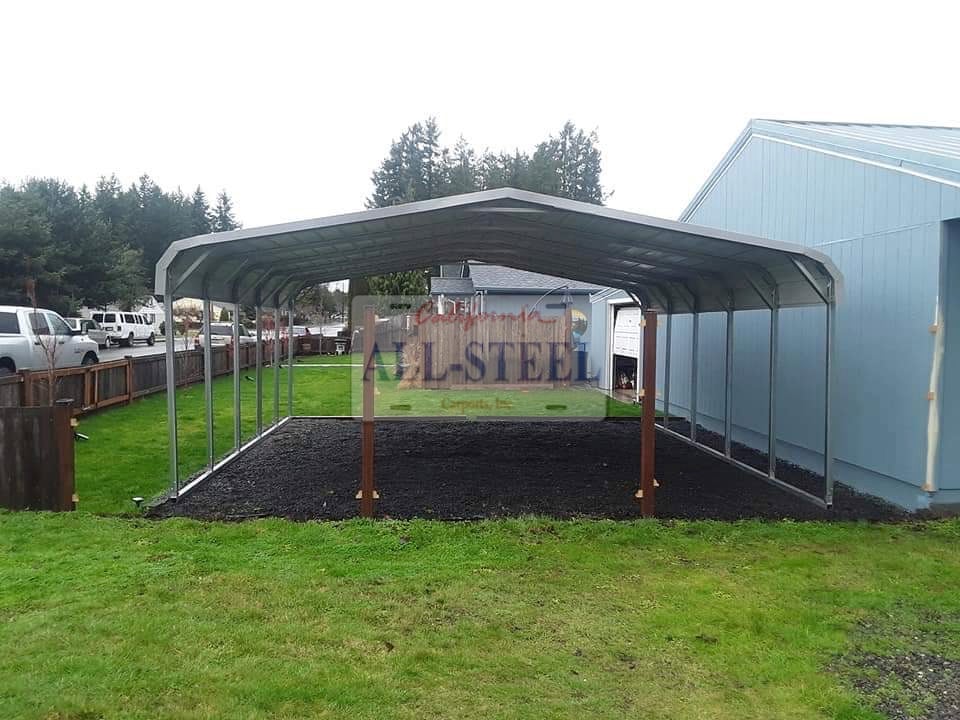Our Difference: All projects include engineering assistance, delivery and installation.
-
Sales & Support Call Now: (844) 918-1997
Our Difference: All projects include engineering assistance, delivery and installation.
Your Metal Carport, Snow Load, & What To Do
For those who own a metal carport, snow load problems are a real threat. In this article, we’ll answer as many questions as possible about your metal carport, snow load issues, and important information.
Snow loads are temporary and variable loads on the roof. They can, however, damage carports if not taken seriously enough.
Snow is one of many factors that may cause damage to carports over time but it usually does so in small increments rather than all at once as earthquakes or hurricanes do. Snow will gradually pile onto roofs until they eventually give way from the pressure – causing everything inside them to fall out as well!
This often leads homeowners with damaged sheds and carports to wonder how their snow loading could have been prevented and we’ll discuss some tips and suggestions in this article.
What is snow load?

When it’s snow and ice build up on your roof, they generate a downward force on your building’s roof. This downward force of accumulated snow and ice on a roof is known as snow load. If weather conditions create a snow load that goes beyond the load limit that the building roof was designed to hold, the roof can become damaged.
Similar to wind load, snow load is a factor that all architects consider during the initial phases of a construction project. For pre-fabricated metal buildings like metal carports, snow load is still a factor for homeowners living in cold areas known for getting lots of snow.
Calculating snow load for carports, roofs, and other structures

Once you’re aware of the definition of snow load, the obvious question becomes “how do I calculate the amount of snow load my roof can take?”. Even well-constructed buildings that are in good condition can be damaged if the snow load on their roof exceeds the weight limit they were designed to manage.
Variables for Roof Snow Loads
Just like wind load, there are several factors to be considered when thinking about your roof’s snow load. By understanding these factors and realizing the limits of your carports, you can hopefully prevent snow-induced damage to your roof.
Snow Load Density
There are different levels of snow loads that are worth considering as you learn about the impact of a snow load on your metal carport or building.
- Light snow load: 5-20 lbs. per square foot
- Packed snow load: 20-40 lbs. per square foot
- Packed snow load with ice: 40-57 lbs. per square foot
- Ice: 57 lbs. per square foot
Now that you are a little more knowledgeable about the different weights classifications for snow loads, let’s look at the variables that can impact the weight and effects of snow loads for your metal building roof.
Snow Accumulation
Accumulation is the rate at which the snow falls and stays on your roof. If your roof gets 6 inches of snow in one day, but warmer weather conditions cause the snow to melt off the following day, the accumulation of snow is not much of a concern.
However, if the temperatures remain low enough after the snowfall that remains on your roof, in addition to any new snow, then accumulation is more of a concern.
It’s also imperative that you think about whether the snow turns into ice since ice weighs more than most types of snow. Ice would be a concern if the snow falls into your roof, then warm weather conditions cause the snow to melt, then colder weather makes it freeze up again.
Either way, you must think about the inclement weather that occurs in the time before and after a snow load begins, not just the snow load itself.
Snow load distribution
As shown in the diagram above, the balance and distribution of a snow load are just as critical as the heaviness of a snow load on your carport or building.
For sake of comparison, let’s think about ground snow. It’s quite easy to walk across a snowy area if it’s all relatively level. But, if there are areas where the snow fall has created mounds and hills, it can be difficult to maneuver.
Just like this example of ground snow, a level and even layer of snow across your roof will mean that the heaviness of the snow load is distributed across the surface of your roof. On the other hand, if the snow load has piled up higher in one or more areas of your roof, it can cause significant strain on the roof of your carport or building.
Drifting snow load
Wind and snow are a dangerous combination for the roofs of metal buildings and other types of structures. Strong blasts of wind can move snow from one area of your roof to another, causing an unbalance in the distribution of the snow load on your roof. An uneven snow load distribution can also result from a poorly designed roof. This is why it’s important to consider wind and snow load concerns when building metal buildings and metal carports on your property.
With just one snow fall, metal carports that are poorly designed will fall under the snow load. Choose California All Steel today and learn why we’re the leading steel building manufacturer on the West Coast!
Sliding snow load
Another concern for metal buildings is a sliding snow load, often caused by gravity. Similar to a drifting snow load caused by wind and snow, this type of snow load occurs when gravity pulls snow down the slope of a vertical roof. In this example of a snow load, metal carports and metal buildings are impacted when snow is pulled by the downward force of gravity off of the roof.
When this snow load finally falls off of the roof, any equipment or valuable items beneath the eaves can be damaged by the weight of the snow load.
Types of structural loads on a metal carport

There are other types of structural loads other than wind and snow load concerns that factor into a building’s design and architecture. In particular, there are dead loads, live loads, environmental loads, and other types of deformation or force applied to a building’s structural elements.
Metal buildings like those at California All Steel are made with a galvanized, 12-gauge steel frame. This means that the steel carports, steel garages, and storage buildings you buy from us are engineered to withstand harsh weather and offer additional storage space for the things you value.
Knowing about the different kinds of forces that can impact your steel garage, steel carport, or other metal building will help you plan a better installation site and ensure that your structures don’t fall at the first sign of high winds or the first snow load.
Dead load
Dead loads are structural forces that remain relatively constant or static over time. Examples of dead loads include building walls, the mass of the building itself, and the building roof. Architects will calculate the load-bearing capacity of a building and include the presence of any static loads. This ensures that engineered drawings for a carport or building allow for structural strength despite the density and mass of the building’s steel roof, galvanized frame, and the many pounds of force exerted by other types of static loads.
Live load
Unlike dead loads, live loads are dynamic and temporary forces upon the frame of metal structures. An example of a live load, or probabilistic load, would be the equipment, workers, and materials used to install roof panels on a metal building.
Applying this to the context of a steel carport, carport covers would be considered dead loads, but anything placed temporarily on the roof would be a live load.
Environmental loads
This type of load is due to natural forces like rain, earthquake, extreme temperature fluctuations, wind, and snow. This is why it’s critical to account for inclement weather while installing carports. In the case of a wind load, your metal buildings are subjected to winds at many miles per hour (mph). Or, during a snow fall, metal buildings can be subjected to the mass of heavy snow.
Types of environmental loads include:
- Snow load
- Wind load
- Seismic loads
- Hydrostatic loads
- Temperature changes
- Pressure exerted by fluids
- Dust loads
Load combinations
Load combinations occur when multiple types of loads exert pressure on a structure. Local building codes often describe many common load comminations and load factors for each load type (like wind and snow load forces). By the way, if you’re building a carport, it’s worth checking out local building codes and zoning regulations to see whether you need a permit to build your steel structure.
How is snow load determined for construction projects?
Structural load data (like those for wind and snow load) is based on numerous factors including:
- Ground snow information by National Weather Service
- The structure, shape, roofline, and any roof obstructions
- The roof’s exposure to wind
- The structural application and its occupancy number
- Thermal values
How to prevent snow loads on your roof?

Given the impact of a snow load on metal buildings, many people with a steel carport will want to take steps to prevent snow loads from being unevenly distributed on the roof of their metal buildings.
Many factors of a snow load can be mitigated through careful building design like implementing a vertical roof style on steel carports. This way, inclement weather that causes high wind or a heavy snow load no longer poses a threat to your metal carport.
Here are a few general tips to prevent or get rid of snow loads that are on the roof of your metal building:
- Use a snow rake, preferably with a telescopic handle, to reach onto the roof of your carport or metal building and pull snow down off of the roof.
- Hire a snow removal contractor that is trained to safely remove snow from off of the roof of canopies, carport covers, or a regular roof.
- Choose a metal building with a good roof design that can handle the load of a heavy snow fall.
Does roof style impact snow load capacity?

One of the main ways to prevent damage from a heavy snow load on your metal building is to invest in metal buildings with a good boxed eave design. Roof angles can either mitigate or worsen the damage from a heavy snow load on a structure. An angled roof can handle a massive load better than a flat roof.
Many types of buildings designed for areas with heavy snow do not have a flat rooftop. Because snow on a flat rooftop will just sit there, with nowhere to go, a flat rooftop would easily collapse under the burden of a heavy snow load. If you live in a snowy climate, it would be wise to not purchase metal buildings or structures with flat covers.
On the other hand, a steeper angled rooftop allows snow to slough slide off of structures, protecting the valuables inside like farm equipment or tools.
What are the factors that impact snow load evaluations?
When an engineer is determining the impact of snow load on a building, they will want to know specific things, such as the year it was built, the materials involved, and the initial wind and snow load capacity limits.
There are other factors that influence the wind and snow load capacity of a structure, including:
Materials: Engineers rely on building code requirements and formulas to calculate the appropriate capacity of a building to handle snow load. Metal buildings, wooden buildings, and concrete buildings each have their own safety concerns and unique structure challenges.
Design & Construction: Another aspect of calculating the wind and snow load of a building comes down to materials. For example, some older buildings built with steel frames used a cantilever beam layout to reduce the size of the beams by using the load on one beam to reduce stress on adjacent beams. However, if a snowfall occurs in an unbalanced manner, the roof will fail to hold up the load.
Depth & Density: Just like with ground snow, the depth of snowfall on a rooftop, as well as the density, are other critical factors in determining the effects of snow load on a structure.
Is a metal carport considered a permanent structure?

As a general rule, a metal carport is only considered to be a permanent structure if it is built on an immovable or non-temporary foundation. Metal carports are great options for car owners who don’t want to store their vehicles under an ugly tarp or deal with a rickety wooden carport.
Are carports good for snow?
For those that live in areas with cold winters and frost-filled mornings, keeping vehicles covered is a must. Otherwise, you’re dealing with frosty windows every morning.
A garage is an ideal option for keeping the frost off of your vehicle. However, if a garage isn’t feasible, a metal carport is a strong option for second best. After installing a carport, many are amazed to discover that there is no frost or very little frost on their vehicle.
Frost occurs when the ground or another surface falls below the freezing point of the air. When this happens, the water in the air will condense and form frost on the ground, your vehicle, and other surfaces.
Because a carport keeps your car and the surrounding ground, it creates a physical barrier that reduces the chance that moisture will accumulate on your vehicle.
How much weight can a metal carport hold?
While carport buyers are researching which carport styles they will choose, it’s common for them to ask about the carport capacity for roof loads. Similar to wind and snow loads, roof loads are calculated by factoring in the size of the beams, joists, and column dimensions for the carport roof and overall structure. Additional factors for a carport roof loads are the dead-load and live-load capacities.
How much snow can carports hold?
This is an important question since you definitely don’t want your roof to collapse during or after a snow fall. Fortunately, most carport roofs can withstand up to 20 pounds PSF (per square foot) of snow fall. Unlike canopies, carport covers are metal buildings are built using galvanized steel frames and are much sturdier than a regular roof for a wooden carport.
The increased strength and durability of metal carport roofs mean that when you’re concerned about snow load, metal buildings are ideal. Steel structures are perfect for shelters, boat covers, sturdy canopies, carport covers, and similar scenarios.
What does snow load certification for metal buildings & carports mean?
As you browse various websites advertising metal carports and other steel structures, you’ve likely come across some companies who say that their carports, boat covers, shed, garage kits, and steel structures are certified.
As you shop online for buildings, metal buildings that are listed as “Certified” will appeal to you since you obviously want the best quality for your property. So what does it mean when steel structures are “certified”?
A certified metal building is designed to comply with local building codes and meet the highest standards of quality within the industry. To be certified, a carport must meet the local building codes (that often vary from one area to another) and also undergo extensive testing to ensure that the building materials and rooftop can withstand high winds and several pounds of snow on it.
Due to its strength and versatility, a certified carport can be used for RV covers, shed, garage kits, equipment shelters, boat storage space, and more!
How do I do a snow load calculation?
To determine the snow load for steel buildings, metal carports, or similar buildings, you’ll need to know the following information:
- The length and width of your carport (or other buildings) roof
- The pitch of your roof, which can vary depending on your carport roof style, like vertical, boxed eave, or standard carport roof
- The type of snow, including fresh, wet, wind-packed, or mixed with ice. If in doubt, choose wetter snow types since they are the densest types.
- The thickness of snow cover, which refers to the number of inches of snow on your carport roof.
At California All Steel, we regularly have to determine the snow load to ensure that our buildings can pass certification requirements. As noted earlier, our 12-gauge, galvanized steel buildings can withstand several pounds of snow and winds of several miles per hour (mph) on their frame.
About California All Steel Buildings
At California All Steel, we pride ourselves on building storage buildings, steel garages, steel carports, and other metal structures made to last. Designed for durability and versatility, we have many different types of buildings that all come with wind and snow load certification so our customers can trust their metal structures.
If you are located in an area with wind and snow loads, our storage buildings, steel garages, metal carports, and other metal structures will withstand inclement weather. When you’re looking for the best buildings, metal is your best bet because it’s strong enough to withstand snow loads of 40 pounds and upward. So, if you want to protect your property, a metal carport is the best choice.

